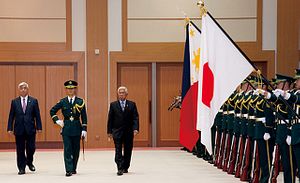The Philippine defense chief said Tuesday that he would discuss with his Japanese counterpart the specific terms of the lease of five Japanese surveillance planes as Tokyo and Manila seek to make further progress in their burgeoning security partnership during the 60th anniversary of the establishment of diplomatic ties.
In March, outgoing Philippine president Benigno Aquino III had confirmed that his country would lease five Beechcraft TC-90 King Air Planes from Japan, which could be used to safeguard the country’s claims in the disputed South China Sea (See: “Philippines to Get Five New Aircraft From Japan Amid South China Sea Tensions”). If finalized, the deal would mark the first time that Japan would lend military aircraft to a foreign country following its lifting of a self-imposed ban on weapons exports.
The announcement came just days after both sides had inked a landmark defense equipment and technology agreement, a significant development in a relationship that has grown quickly over the past few years amid rising concerns about China’s assertiveness in the East China Sea and South China Sea (See: “Japan, Philippines Boost Defense Ties”). The pact was just the fourth Tokyo has signed with any country.
On Tuesday, Defense Secretary Voltaire Gazmin had a telephone call with Japan’s defense minister Gen Nakatani where he said he “reaffirmed the transfer” of the planes, according to the Philippine defense ministry. He also said that he would have talks with Japan’s defense minister Gen Nakatani about the terms of lease of TC-90s when they meet in Laos for the ASEAN Defense Ministers’ Meeting (ADMM-Plus) this month.
Philippine defense officials had previously emphasized that the actual terms and conditions of the lease agreement, including the cost and duration, were still being finalized. As I have noted before, while the cash-strapped Philippines had initially wanted the planes for free, the TC-90 aircraft, which constitute Japanese defense equipment, will have to be transferred in accordance with the Three Principles of Transfer on Defense Equipment and Technology approved by Tokyo in April 2014 governing arms exports.
Details aside, the TC-90s, currently used to train Japanese Self Defense Force pilots, would indeed be a boost for the Philippines’ capabilities and can be deployed for a variety of purposes ranging from disaster response missions to maritime security operations. Furthermore, as Manila currently does not have enough aircraft to conduct regular patrols in the South China Sea, and the planes could be fitted with basic surface and air surveillance radar for surveillance as Manila responds to China’s threat to Philippine claims there (See: “The Truth About Philippine Military Modernization and ‘The China Threat’”). With a range of about 1,900 kilometers, the TC-90s will also roughly double the area that Philippine aircraft can now patrol.
Nakatani was initially scheduled to visit the Philippines last month, but the trip was postponed due to the twin earthquakes in southern Japan (See: “Japan’s Defense Minister to Visit Philippines to Boost Security Ties”). Both ministers have said that they will attempt to reschedule that meeting.
Earlier this year, Emperor Akihito and Empress Michiko had visited the Philippines from January 26 to January 30, the first such trip by a Japanese emperor to the Southeast Asian state. Japan and the Philippines have been strategic partners since 2011.

































